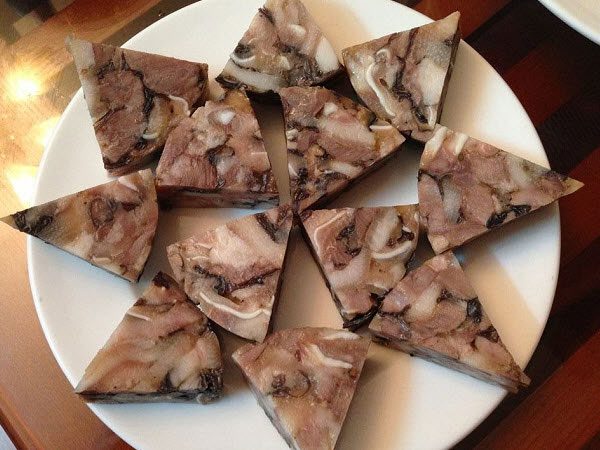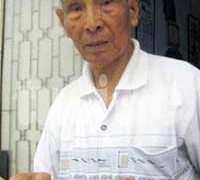Thịt đầu (Giò thủ) is one of the quintessential dishes of the Vietnamese during the Lunar New Year. However, it contains a high amount of fat and calories, so it should not be consumed in excess or too frequently to avoid weight gain.
On the Tet holiday table, in addition to Bánh Chưng (square sticky rice cake), chicken, bamboo shoot soup, Giò Lụa (Vietnamese pork sausage), or Đông (cold meat), Thịt đầu is also a popular dish favored by many people, especially suited to the cold winter weather of Northern Vietnam.
Thịt đầu, as its name suggests, is primarily made from various parts of the pig’s head, such as the ears, snout, cheeks, and may also include the tongue or leg meat. In addition to these main ingredients, other essential components like wood ear mushrooms, shiitake mushrooms, and pepper are also needed to create a delicious dish.
Our ancestors believed that a plate of Thịt đầu symbolizes hope for a prosperous, warm, and bountiful year. To prepare this dish, families must be meticulous in selecting ingredients and the cooking process. Thịt đầu is generally easy to eat as it complements rice well, but experts advise against consuming it in large quantities.
Dr. Nguyen Trong Hung, head of the Adult Nutrition Consultation Department at the National Institute of Nutrition, asserts that Thịt đầu is made from fatty parts like the head, cheeks, and snout. Because of its high fat content, consuming too much can lead to excess energy intake and potential weight gain during the Tet holiday.

Experts recommend that families should make it themselves to control the source of the dish.
When consuming Thịt đầu, people should be mindful of their energy intake by eating less; it is recommended to taste it rather than eat it to fullness.
Thịt đầu is relatively easy to make, and families should prepare it themselves to ensure control over its origin. When making this dish, it is essential to choose fresh meat to guarantee high nutritional value and quality.
When preparing Thịt đầu, if you add ingredients like wood ear mushrooms or shiitake mushrooms, they must be stored carefully; otherwise, they can spoil quickly.
Dr. Hung warns that improper food storage can increase the risk of poisoning. If Thịt đầu appears spoiled, do not hesitate to discard it; consuming it can lead to digestive disorders or even serious food poisoning requiring hospitalization.
According to Associate Professor Dr. Nguyen Duy Thinh, a food technology expert, Thịt đầu is a dish created by people to save food resources, especially the parts of the pig’s head.
To prepare Thịt đầu, ingredients such as pig cheeks, neck, ears, and tongue are needed. All of these meats are stir-fried to achieve a cohesive texture, then wood ear mushrooms and shiitake mushrooms are added for flavor, along with some fish sauce and pepper.
Food preservation for Thịt đầu is particularly emphasized by food technology experts. While Thịt đầu is delicious, it has the disadvantage of being suitable only in cold weather. In hot or humid weather, it spoils quickly. Therefore, the preservation process is crucial. In deep cold weather, the whole unconsumed Thịt đầu can be left outside. Once cut, it should be stored in the refrigerator. In hot weather, after the Thịt đầu is set in a mold, it should be immediately placed in the fridge.
Every time you take Thịt đầu out to cut and eat, it should be tightly wrapped with plastic wrap. Leaving it exposed in hot weather will cause it to melt, lose its cohesiveness, and spoil easily.

Families must be careful and meticulous in removing any lumps to ensure the dish’s quality.
Associate Professor Nguyen Duy Thinh notes that the most concerning issue with Thịt đầu is the quality of the meat, as it is made from parts of the neck and head, which may contain many lumps, also known as lymph nodes. Therefore, families must be very careful and meticulous in removing any lumps or hair to ensure the highest quality of the dish.
“The lumps on the neck and head of the pig are actually lymph nodes, which can be grayish-white or light yellow. These nodes can harbor pathogens such as bacteria and viruses, emit unpleasant odors, and can directly transmit disease into the body, making them difficult to eradicate even when cooked at high temperatures. Therefore, regardless of the preparation method or the dish being made, these lumps must be thoroughly removed,” Associate Professor Nguyen Duy Thinh advises.
To ensure safety when consuming Thịt đầu, Associate Professor Thinh recommends that families should make it themselves; when purchasing from shops, they may not prepare it carefully, especially concerning the removal of harmful lumps.




















































